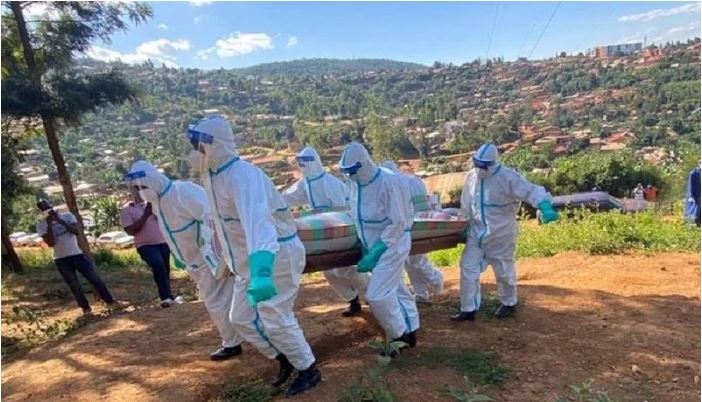
Dr Ngamije addressing the virtual World Health Summit on Monday.
The Minister of Health Dr Daniel Ngamije says Non-Communicable Diseases (NCDs) have become a huge burden for the country, killing more people than any other cause of death, calling for more funding and strategies to combat them.
Dr Ngamije made the observation on Monday, while taking part in the virtual World Health Summit -an annual global summit held in Berlin, to set the healthcare agenda and rally support for the 2030 Agenda for health and technological innovations to improve access to healthcare.
In his presentation, Dr Ngamije gave a picture of the state of NCDs in Rwanda, the different strategies the government is deploying to combat them and the future impact of non-communicable diseases on health financing.
“NCDs and injuries are the leading cause of death and disability in Rwanda. They have become a huge burden for the country, with almost 59 percent of cases of death we are getting in our health facilities a result of NCDs and injuries,”
“Last year alone, we had 34,000 new NCDs cases enrolled for care and DALYs (Disability-Adjusted Life Years) associated with NCDs rose from 16% in 1990 to 35% in 2016, indicating significant productivity loss for our population in Rwanda,” Dr Ngamije told the summit.
He pointed out that the number of patients presented at a late stage with disease complications in Rwanda has continued to increase due to late diagnosis.
The Minister of Health said that Rwanda, like most low-middle-income countries, faces the challenge of late detection of NCDs, usually after the disease has shown complications, citing conditions such as blood pressure, Cardiovascular disease and Cancer as some of the conditions that continue to manifest themselves.
According to the Ministry of Health, 15.9 percent of adults in Rwanda are living with hypertension while 40 percent of adults present for the first time with heart failure class III to IV. The number of Cardiovascular patients treated in the country’s health facilities has more than tripled between 2018 and 2020, from 25,353 to 88,486 cases.
Similarly, the number of men and women diagnosed with cancer increased from 3,000 in 2018 to 10,400 new cases currently estimated by WHO, indicating a high prevalence of the killer disease.
Dr Ngamije said that Rwanda has been successful in reducing the burden of communicable diseases and improving maternal and childhood care, but now more focus must be put on NCDs which are increasingly killing more people.
He said however that this could be attributed to improved testing and detection, even though still low, which in a way helps the government to know the actual impact of NCDs, compared to the past, where testing and detection were at a very low base.
Dr Ngamije said that the detection coverage rate for chronic respiratory diseases such as asthma and conditions such as diabetes remains low and more needs to be done to increase testing and ensure early detection.
According to MINISANTE, Asthma affects 1.1 percent of the population in Rwanda. In 2019, some 10,741 persons with asthma were enrolled in care, presenting a coverage rate of around 7.5 percent while the prevalence of diabetes is estimated at between 3 percent and 3.5%.
In 2019, 15,673 persons with diabetes were enrolled in care, with a coverage rate of around 4 percent, a number he said is very low. Dr Ngamije said that more screening and disease detection is needed.
Enter COVID-19
Though the country has seen an upsurge of NCD numbers in recent years, the outbreak of the New Coronavirus has complicated the problem further, as underlying conditions contributed in fragilizing people with COVID-19.
The Minister of Health said that though Rwanda has been successful in containing the virus, registering 34 deaths out of 5,073 cases, accounting for 0.7 percent, 90 percent of the deaths had NCD Co-morbidity detected, meaning that majority of the people who died had underlying conditions related to NCDs.
He said that Rwanda was only able to keep the fatality rate of COVID-19 low because of early intervention and a health system that has greatly improved access to services for the majority of Rwandans. Globally, COVID-19 proved that people with underlying conditions were more susceptible to the virus.

The Minister said that the majority of COVID-19 patients were aged between 20 and 59 and few of them were beyond 65 and it is in that age group that a huge number of cases of death with comorbidities were registered.
More Financing needed
Bearing the numbers in mind, with Rwanda setting its sights on Vision 2050, Dr Ngamije said that the country needs to act now to ensure that the devastating impact of NCDs must be nipped in the bud by acting now rather than later.
To reverse this issue, Dr Ngamije said that Rwanda is working on the NCD strategic plan whose action plan has already been developed and the government is currently mobilising resources, including domestically, to fund the different initiatives. Clearly, we need to address the issue of universal health average coverage so that we can increase early detection of NCDs,”
“When we observe what we spend on NCDs, it’s clear that we are spending less compared to other diseases. 0.8 percent to 2 percent represents our health expenditure on NCDs, and for prevention, we are also spending less compared to other diseases. We need to invest more so that we can change this trend and address the rising burden of NCDs,” the Minister of Health said.
Of the $221.7 million Rwanda spent on disease prevention and control programs, less than 1.7 percent was spent on NCDs. Dr Ngamije said that the Government of Rwanda is committed to change this trend.
He highlighted some of the key initiatives the government has put in place in line with the NCDs National Strategic Plan and Vision 2050, affirming the political will to address the burden of NCDs.
Under the 5-year National Costed Action Plan for NCDs, Rwanda is planning to spend some $638 million over the next 5 years to tackle NCDs.

Dr Ngamije said that activities like Car Free Day will be key in battling NCDs.

